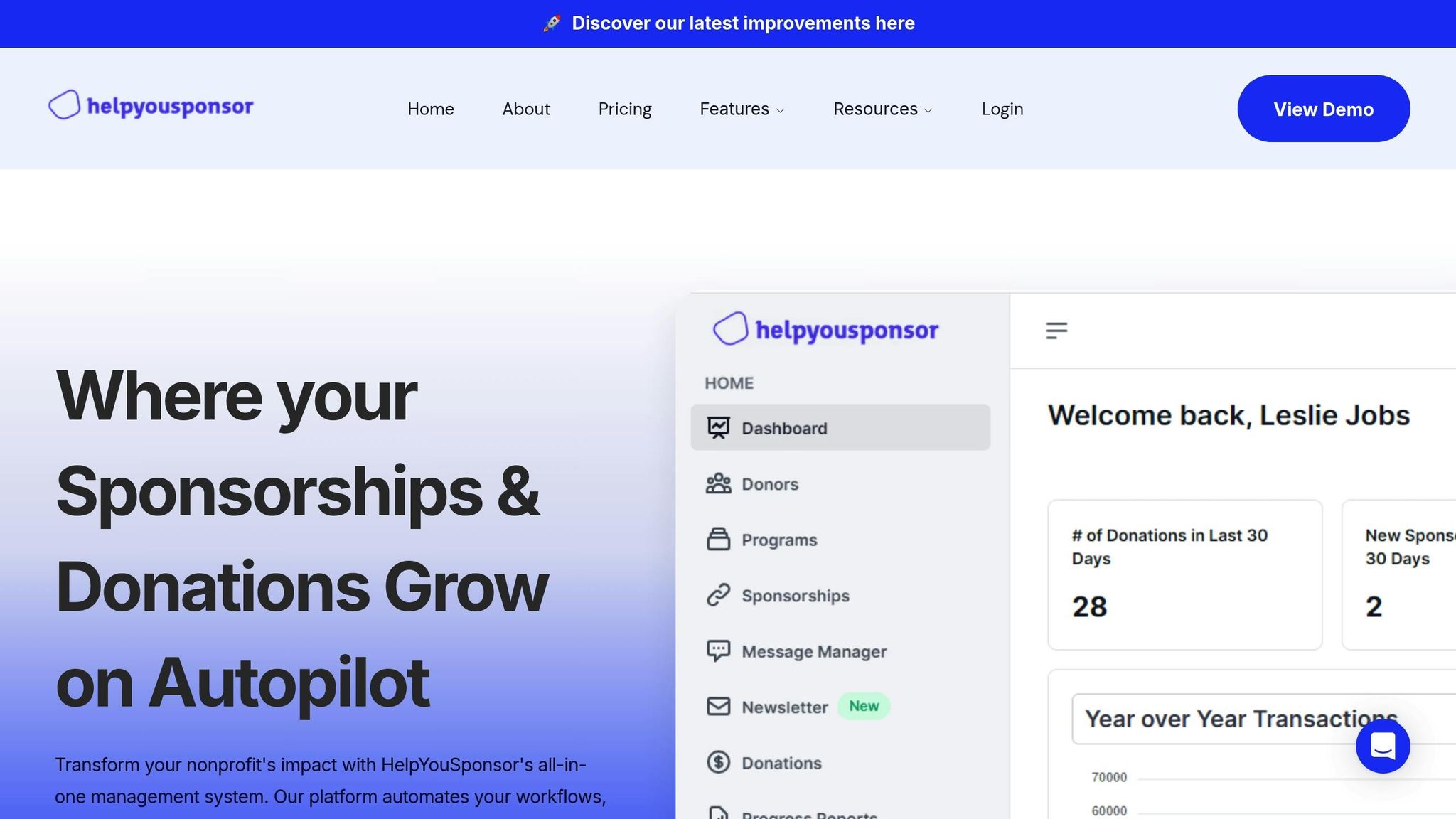Ultimate Guide to AML/CTF for Nonprofits
Nonprofits must prioritize AML/CTF compliance to protect their mission and ensure donor trust amidst increasing regulatory scrutiny.

Nonprofits face growing scrutiny over Anti-Money Laundering (AML) and Counter-Terrorism Financing (CTF) compliance, especially those managing international sponsorship programs.
Here's what you need to know:
- AML/CTF Basics: These frameworks aim to prevent misuse of financial systems for money laundering or terrorism financing.
- Why Nonprofits Are Vulnerable: Cross-border operations, large donation volumes, and limited oversight resources increase risks.
- Key U.S. Regulations: Nonprofits must comply with laws like the Bank Secrecy Act and USA PATRIOT Act, focusing on financial transparency and reporting.
- Core Requirements: Conduct risk assessments, perform due diligence for donors and partners, and monitor transactions regularly.
- Cross-Border Challenges: Varying global regulations, language barriers, and differing legal systems complicate compliance.
- Technology's Role: Tools like HelpYouSponsor simplify compliance with centralized donor management, automated due diligence, and detailed reporting.
Why it matters: Strong compliance measures protect your nonprofit’s mission, build trust with donors, and ensure resources reach the intended communities. Failure to comply can lead to penalties and reputational damage.
This guide explains how to navigate compliance effectively while maintaining your organization's integrity and purpose.
POTENTIAL EFFECT ON LEGITIMATE NGOs AS BOTSWANA INTENSIFIES EFFORTS ON REGULATION
Core AML/CTF Requirements for Nonprofits
Protecting your organization and its mission starts with compliance. A risk-based approach tailored to your nonprofit's size, geographic reach, and activities is crucial.
Risk Assessments and Controls
Begin with a risk assessment to identify where your organization may be vulnerable. As your programs evolve, updating these assessments regularly is essential.
To map your risk profile, consider factors like the regions where you operate, your partners, and the services you provide. For example, nonprofits working in politically unstable areas or regions with weak financial oversight face heightened risks. Similarly, activities like cash transfers, emergency relief, or partnerships with local organizations demand stricter controls.
Implementing controls might include steps like enhanced screening for high-risk regions, additional approval layers for large transactions, or more frequent monitoring of partner organizations. High-quality, consistent data is critical here - it minimizes false positives and ensures genuine risks are flagged.
These controls set the stage for thorough due diligence, helping you vet donors and partners effectively.
Due Diligence for Donors and Partners
Once your risks are mapped, conduct due diligence to verify identities and assess the sources of funds. This applies to everyone you engage with - donors, board members, partners, vendors, volunteers, and even beneficiaries in certain cases.
For donors, it’s important to understand their backgrounds and funding sources, especially for larger or recurring contributions. While small donors don’t usually require extensive scrutiny, significant donations call for deeper checks. Mark Lomas, Global Head of Assurance at WaterAid, emphasizes the growing need for donor screening:
"Increasingly, large institutional and corporate donors are expecting there to be some kind of screening checks."
When it comes to partners, verifying their legitimacy and reputation is equally important. This means reviewing their registration, financial records, and compliance measures before formalizing any agreements. International partnerships add complexity due to differing regulations and documentation standards, but these steps are essential.
To make compliance seamless, integrate screening into your operational workflows. For instance, include initial screenings in the partner selection process and embed AML checks into payment or grant approvals. This approach balances compliance with operational efficiency. Han van Kammen, Compliance Coordinator at DanChurchAid, highlights this balance:
"We need an AML process that works practically in the field. It must be accurate, but it also should fit how our teams actually work."
Monitoring and Reporting Requirements
Risk assessments are just the beginning - continuous monitoring is key to spotting anomalies and ensuring timely reporting. Your organization needs strong systems for ongoing monitoring, which can combine automated tools and manual reviews to flag unusual patterns or behaviors.
Pay close attention to anomalies like unusually large donations or frequent transactions that hover near reporting thresholds. Establish a baseline for normal operations, and ensure all transaction records and supporting documentation are well-maintained and accessible for audits.
If you detect suspicious activity, report it immediately to the relevant authorities. This is a legal requirement and a safeguard for both your organization and the financial system. Reporting obligations vary by jurisdiction but generally involve filing suspicious activity reports with financial intelligence units.
Staff training is critical for effective monitoring. Team members need to recognize suspicious activity relevant to your operations and know how to escalate concerns. Regular, role-specific training ensures everyone understands their responsibilities. Providing clear guidance and playbooks for handling screening alerts helps staff respond consistently and efficiently.
Tailor your monitoring efforts to match risk levels. This ensures your approach remains practical while complementing broader risk management strategies.
Cross-Border AML/CTF Challenges
Navigating anti-money laundering (AML) and counter-terrorism financing (CTF) compliance across international borders is no small feat for nonprofits. Different regulations, language barriers, and limited resources create a maze of challenges that demand careful planning and actionable solutions.
Different Laws Across Countries
Every country has its own AML/CTF rules, meaning what works in one jurisdiction might violate laws in another.
Take the Charities Aid Foundation (CAF) Group as an example. In the 2019/2020 financial year, CAF distributed over £700 million (around $930 million) across more than 100 countries, each with its own unique regulations. Handling such a large-scale operation requires a deep understanding of multiple legal systems.
Another hurdle is the lack of unified registers and reliable listings, which complicates verifying partners and beneficiaries across borders. Add to that the challenges of working in regions with different languages and legal traditions, and misunderstandings become almost inevitable.
The stakes for getting it wrong are incredibly high. In 2022, global fines for money laundering and related financial crimes jumped by more than 50%, with banks alone facing penalties exceeding $2 billion. For nonprofits, non-compliance could mean losing access to essential banking services, as financial institutions may refuse to work with organizations that lack robust AML/CTF measures.
These legal and operational differences force nonprofits to adopt flexible and effective compliance approaches.
Risk Management Strategies
Strong risk management starts with detailed assessments. Nonprofits need to pinpoint the specific risks tied to international money transfers and the countries where they operate.
Clear compliance protocols are a must. These should include enhanced Know Your Customer (KYC) processes and transaction monitoring systems designed for cross-border activities.
Training staff is equally important. Teams must not only understand the technical aspects of cross-border transactions but also be aware of the cultural nuances involved.
"We need an AML process that works practically in the field. It must be accurate, but it also should fit how our teams actually work."
Collaboration with law enforcement and other organizations can also make a big difference. For instance, the UK's Joint Money Laundering Intelligence Taskforce (JMLIT) has shown how partnerships can uncover complex financial crime schemes spanning multiple countries.
Europol's Anti-Money Laundering Operational Network (AMON) offers another example. Its collaboration with the U.S. Department of Justice led to the dismantling of a global money laundering network, recovering over $100 million in illicit funds.
Technology for Cross-Border Compliance
Technology is becoming a key ally in tackling cross-border AML/CTF challenges.
RegTech solutions can automate compliance tasks, improve detection rates, and simplify international reporting. AI-powered platforms analyze global data to spot risks that traditional methods might overlook. Blockchain technology offers secure, tamper-proof record-keeping that meets the demands of regulators across different jurisdictions. Additionally, interoperable platforms allow real-time sharing of financial crime intelligence.
Cryptocurrency adds another layer of complexity. Nonprofits need tools capable of tracking and verifying digital asset transactions across diverse regulatory landscapes.
However, technology isn’t a silver bullet. The European Banking Authority has cautioned against over-relying on automation:
"De-risking continues to pose ML/TF risks, because customers affected by de-risking may resort to alternative payment channels in the EU and elsewhere to meet their financial needs. As a result, transactions may no longer be monitored, making the detection and reporting of suspicious transactions and, ultimately, the prevention of ML/TF more difficult."
Support for smaller jurisdictions is also critical. For example, the Asia/Pacific Group on Money Laundering (APG) provides technical assistance to help member countries align with global standards, highlighting the importance of collaborative efforts.
Balancing advanced technological tools with thoughtful human oversight is essential to safeguarding nonprofits’ international operations.
Using HelpYouSponsor for AML/CTF Compliance

HelpYouSponsor steps in to simplify the complex world of AML/CTF compliance, especially for nonprofits managing international sponsorship programs. By reducing resource demands and lightening the workload, it provides tools that align perfectly with the risk assessments and monitoring strategies already in place. The platform specifically targets the challenges nonprofits face when handling cross-border donations and sponsorships while staying compliant with regulations.
Centralized Donor and Transaction Management
Imagine having all donor information securely stored in one place - that’s exactly what HelpYouSponsor offers. By consolidating donor data, tracking donations, and keeping detailed records, the platform ensures your organization is well-prepared for audits. Regulatory authorities expect thorough documentation, and this tool delivers just that.
HelpYouSponsor acts as a single source of truth for your nonprofit. Instead of juggling multiple systems, you can access everything - donor profiles, transaction histories, and communication records - all in one location. This is especially helpful for managing cross-border sponsorships, where donations come from different countries. The platform tracks currency conversions, timestamps all activities, and maintains clear audit trails for every transaction.
Additionally, integrated payment gateways ensure all transactions are processed through monitored systems. This reduces the risks associated with informal payment methods or untracked transfers, keeping your compliance efforts on solid ground.
Automated Due Diligence and Reporting
HelpYouSponsor takes the hassle out of customer due diligence (CDD), a critical step in verifying donors before they contribute. Its automated workflows help nonprofits meet AML/CTF requirements across various jurisdictions without overburdening compliance teams. With electronic identity verification, donor identities can be confirmed quickly and efficiently - no need for time-consuming manual checks.
The platform’s advanced risk assessment tools use sophisticated algorithms to evaluate donor risk profiles based on factors like location and occupation. This allows your team to focus on higher-risk cases while fast-tracking approvals for low-risk donors. Continuous monitoring keeps an eye on donor behavior, flagging any unusual activities. Plus, the system integrates with up-to-date data sources, including sanctions lists, watchlists, and PEP databases.
Clear Reporting for Audits
When it comes to audits, clear and organized reporting can make all the difference. HelpYouSponsor makes compliance reviews less stressful by generating detailed donation tracking reports that meet the expectations of auditors and regulatory authorities.
The platform maintains a complete transaction history for every donation, including timestamps, currency details, and supporting documentation like donor communications, verification steps, and risk assessments. This creates a comprehensive compliance record for each contribution.
Automated receipt generation ensures every transaction is properly documented. These standardized receipts include all the necessary information for tax and regulatory purposes, cutting down on administrative tasks.
Need to prepare reports for an audit? The platform’s export features allow you to create reports in formats like Excel, PDF, or detailed transaction logs - whatever works best for your auditors. User access logs also track every data review, providing the accountability trail required by compliance frameworks. This is particularly useful when multiple team members manage donor relationships across different programs or regions.
Lastly, the built-in messaging system ensures all donor communications are logged. This not only adds transparency but also provides context for donation decisions, which can be invaluable during an audit.
U.S.-Specific Compliance Requirements
U.S. regulations expand on general AML/CTF practices by introducing specific mandates aimed at enhancing financial transparency and accountability. While nonprofits are generally considered low-risk, they must still adhere to strict AML/CTF standards.
Currency, Date, and Reporting Standards
Financial records in the U.S. must follow specific formatting rules: amounts are recorded in U.S. dollars, using commas for thousand separators and a period for decimals (e.g., $1,234.56). Dates are formatted as MM/DD/YYYY to ensure consistency, especially when dealing with international donations.
The Financial Crimes Enforcement Network (FinCEN) oversees AML/CTF compliance in the U.S. through the enforcement of the Bank Secrecy Act. FinCEN has the authority to examine financial institutions and enforce compliance measures. Nonprofits that handle significant cash transactions are required to file Currency Transaction Reports (CTRs) and Suspicious Activity Reports (SARs) to monitor and report any unusual activities.
Although there are no Bank Secrecy Act regulations written specifically for nonprofits, they are subject to the same requirements as other account holders. These include customer identification, due diligence, beneficial ownership verification, and suspicious activity reporting. This approach reflects the government’s stance that charitable organizations generally do not pose a high or uniform risk for money laundering or terrorist financing. However, nonprofits must still maintain robust internal controls and conduct compliance testing to meet regulatory standards.
Violations of the USA PATRIOT Act carry severe penalties, including fines of up to $1 million or double the transaction amount - whichever is greater. These stringent recordkeeping and reporting standards are designed to uphold the transparency required by U.S. laws.
Transparency Expectations in the U.S.
Transparency plays a critical role in building trust with the public and regulatory bodies. Nonprofits in the U.S. are required to publicly disclose key documents, such as their three most recent IRS Form 990s, tax-exemption applications, audited financial statements, and details regarding board oversight, to foster donor confidence.
Clear and honest communication with donors is another essential aspect of transparency. Solicitation materials must accurately explain how contributions will be used, including administrative costs and program funding. Strong financial management practices and internal controls further ensure that funds are used appropriately and responsibly.
Board oversight is equally important in maintaining transparency. Boards are expected to review financial reports and IRS Form 990 filings regularly. Many nonprofits also publish the names and affiliations of their board members on their websites to demonstrate accountability. Policies addressing conflicts of interest, executive compensation, and whistleblower protections further reinforce ethical governance.
State charity officials provide an additional layer of oversight by investigating financial misconduct. Nonprofits can also enhance public trust by maintaining updated profiles on platforms like Guidestar, which offer detailed organizational information to donors and stakeholders.
Between 2013 and 2021, Treasury analysis revealed that 15.4% of registered investment advisors and exempt reporting advisors were linked to at least one Suspicious Activity Report, with SAR filings in this sector increasing by about 400% during that time. While this data primarily pertains to investment advisors, it underscores the heightened financial scrutiny that nonprofits must navigate.
For organizations managing cross-border sponsorship programs, these transparency standards are especially critical. Detailed documentation of international transactions, donor communications, and program outcomes is essential for demonstrating the legitimacy of charitable activities and maintaining trust with donors and regulators alike.
Conclusion
AML/CTF compliance isn’t just about following the rules - it’s about protecting your mission and ensuring the financial system remains trustworthy. As Deputy Secretary of the Treasury Wally Adeyemo noted, "More than ever, financial institutions are partnering with government to address a range of serious law enforcement and national security issues with illicit financing implications, from fentanyl trafficking to Russia's illegal invasion of Ukraine." Nonprofits are also part of this effort, playing a critical role in preserving the integrity of charitable giving.
Strong compliance policies do more than safeguard financial systems - they build donor trust. Failing to put proper controls in place can lead to severe consequences, including financial penalties and long-term damage to your organization’s reputation.
For nonprofits managing cross-border sponsorship programs, compliance can feel overwhelming due to varying regulations, reporting standards, and transparency requirements across countries. This is where technology steps in. Tools like HelpYouSponsor simplify the process by offering centralized management and automated compliance features, reducing complexity and saving time.
The key is to shift the perspective on compliance. Instead of seeing it as a burden, view transparency as an opportunity - a way to strengthen your organization’s credibility and build a foundation for sustainable growth. By adopting robust AML/CTF frameworks, engaging in self-regulation within the nonprofit sector, and using purpose-built technology, nonprofits can protect their mission and the communities they serve.
Global cooperation is vital in the fight against money laundering and terrorist financing. Your compliance efforts don’t just protect your organization - they contribute to safeguarding the charitable sector as a whole. By maintaining high standards for donor verification, transaction monitoring, and reporting, you’re ensuring that nonprofits can continue to operate effectively across borders.
FAQs
How can nonprofits ensure compliance with AML/CTF regulations while maintaining efficiency in their cross-border operations?
Nonprofits can manage compliance effectively while maintaining efficiency by implementing clear, standardized policies that align with AML/CTF regulations. Providing staff with proper training on these requirements helps ensure smoother operations and minimizes the chances of mistakes.
Using technology tailored for nonprofit needs is another smart move. Tools that assist with tasks like transaction monitoring, donor verification, and record-keeping can simplify compliance efforts. This approach not only saves time but also reduces administrative expenses, enabling organizations to dedicate more resources to their core mission. Additionally, building strong partnerships with international collaborators and staying updated on regulatory changes allows nonprofits to navigate compliance demands without sacrificing operational performance.
What challenges do nonprofits face when applying AML/CTF measures in politically unstable regions?
Nonprofits working in regions with political instability often encounter significant hurdles when trying to implement Anti-Money Laundering (AML) and Counter-Terrorism Financing (CTF) measures. The lack of reliable systems or governance in such areas makes it challenging to assess risks and maintain compliance effectively.
Another pressing issue is the potential misuse of humanitarian aid for illegal activities. Limited access to banking services in these regions adds another layer of complexity, making financial oversight even more difficult. These factors create opportunities for financial system abuse, complicating efforts to identify and prevent money laundering or terrorist financing.
However, nonprofits can address these risks by adopting strong compliance practices and using tools specifically designed to support their operations. These steps can help ensure their programs remain aligned with AML/CTF requirements, even in challenging environments.
How can technology like HelpYouSponsor help nonprofits stay AML/CTF compliant across different countries?
Technology platforms such as HelpYouSponsor are essential for helping nonprofits stay compliant with AML/CTF regulations, even when working across different countries. These platforms utilize advanced tools like machine learning to monitor transactions in real-time, identifying any unusual or suspicious activities that could signal potential risks.
On top of that, they simplify cross-border collaboration and data sharing, which allows organizations to meet international standards and perform detailed due diligence more efficiently. This helps nonprofits manage complex regulatory demands and remain compliant, no matter where they operate.

